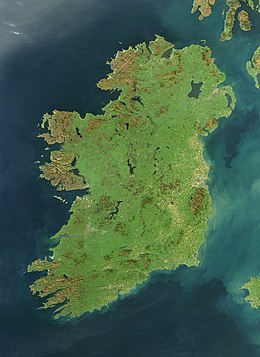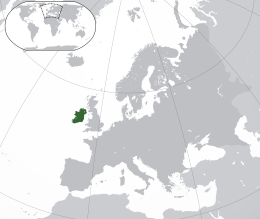| |
|---|---|
 Satellite image, October 2010 | |
 Location of Ireland (dark green) in Europe (dark grey) | |
| Geography | |
| Location | Northwestern Europe |
| Coordinates | 53°N 8°W / 53°N 8°W |
| Archipelago | British Isles |
| Adjacent to | Atlantic Ocean |
| Area | 84,421 km2 (32,595 sq mi)[1] |
| Area rank | 20th[2] |
| Coastline | 7,527 km (4677.1 mi)[3][4] |
| Highest elevation | 1,041 m (3415 ft) |
| Highest point | Carrauntoohil |
| Administration | |
| Largest city | Dublin, pop. 1,458,154 Metropolitan Area (2022)[5] |
| Country | Northern Ireland |
| Largest city | Belfast, pop. 671,559 Metropolitan Area (2011)[6] |
| Demographics | |
| Demonym | Irish |
| Population | 7,185,600 (2023 estimate)[a][7] |
| Population rank | 19th |
| Pop. density | 82.2/km2 (212.9/sq mi) |
| Languages | |
| Ethnic groups | |
| Additional information | |
| Time zone | |
| • Summer (DST) | |
Ireland (/ˈaɪərlənd/ IRE-lənd; Irish: Éire [ˈeːɾʲə] ; Ulster-Scots: Airlann [ˈɑːrlən]) is an island in the North Atlantic Ocean, in north-western Europe. It is separated from Great Britain to its east by the North Channel, the Irish Sea, and St George's Channel. Ireland is the second-largest island of the British Isles, the third-largest in Europe, and the twentieth-largest in the world.[10] Geopolitically, the island is divided between the Republic of Ireland (officially named Ireland), a sovereign state covering five-sixths of the island, and Northern Ireland, which is part of the United Kingdom. As of 2022, the population of the entire island is just over 7 million, with 5.1 million in the Republic of Ireland and 1.9 million in Northern Ireland, ranking it the second-most populous island in Europe after Great Britain.[11]
The geography of Ireland comprises relatively low-lying mountains surrounding a central plain, with several navigable rivers extending inland. Its lush vegetation is a product of its mild but changeable climate which is free of extremes in temperature. Much of Ireland was woodland until the end of the Middle Ages. Today, woodland makes up about 10% of the island, compared with a European average of over 33%,[12] with most of it being non-native conifer plantations.[13][14] The Irish climate is influenced by the Atlantic Ocean and thus very moderate,[15] and winters are milder than expected for such a northerly area, although summers are cooler than those in continental Europe. Rainfall and cloud cover are abundant.
Gaelic Ireland had emerged by the 1st century AD. The island was Christianised from the 5th century onwards. During this period Ireland was divided into many petty kingships under provincial kingships (Cúige "fifth" of the traditional provinces) vying for dominance and the title of High King of Ireland. In the late 8th century to early 11th century AD Viking raids and settlement took place culminating in the Battle of Clontarf on 23 April 1014 which resulted in the ending of Viking power in Ireland. Following the 12th century Anglo-Norman invasion, England claimed sovereignty. However, English rule did not extend over the whole island until the 16th–17th century Tudor conquest, which led to colonisation by settlers from Britain. In the 1690s, a system of Protestant English rule was designed to materially disadvantage the Catholic majority and Protestant dissenters, and was extended during the 18th century. With the Acts of Union in 1801, Ireland became a part of the United Kingdom. A war of independence in the early 20th century was followed by the partition of the island, leading to the creation of the Irish Free State, which became increasingly sovereign over the following decades until it declared a republic in 1948 ( Republic of Ireland Act, 1948) and Northern Ireland, which remained a part of the United Kingdom. Northern Ireland saw much civil unrest from the late 1960s until the 1990s. This subsided following the Good Friday Agreement in 1998. In 1973, both the Republic of Ireland and the United Kingdom, with Northern Ireland as part of it, joined the European Economic Community. Following a referendum vote in 2016, the United Kingdom, Northern Ireland included, left the European Union (EU) in 2020. Northern Ireland was granted a limited special status and allowed to operate within the EU single market for goods without being in the European Union.[16]
Irish culture has had a significant influence on other cultures, especially in the field of literature. Alongside mainstream Western culture, a strong indigenous culture exists, as expressed through Gaelic games, Irish music, Irish language, and Irish dance. The island's culture shares many features with that of Great Britain, including the English language, and sports such as association football, rugby, horse racing, golf, and boxing.
- ^ Nolan, William. "Geography of Ireland". Government of Ireland. Archived from the original on 24 November 2009. Retrieved 11 November 2009.
- ^ Royle, Stephen A. (1 December 2012). "Beyond the boundaries in the island of Ireland". Journal of Marine and Island Cultures. 1 (2): 91–98. Bibcode:2012JMICu...1...91R. doi:10.1016/j.imic.2012.11.005. ISSN 2212-6821.
- ^ "Irish Coastal Habitats: A Study of Impacts on Designated Conservation Areas" (PDF). heritagecouncil.ie. Heritage Council. Archived (PDF) from the original on 3 December 2020. Retrieved 2 November 2020.
- ^ Neilson, Brigitte; Costello, Mark J. (22 April 1999). "The Relative Lengths of Seashore Substrata Around the Coastline of Ireland as Determined by Digital Methods in a Geographical Information System". Estuarine, Coastal and Shelf Science. 49 (4). Environmental Sciences Unit, Trinity College, Dublin: 501–508. Bibcode:1999ECSS...49..501N. doi:10.1006/ecss.1999.0507. S2CID 128982465. Archived from the original on 13 July 2021. Retrieved 13 July 2021.
- ^ "Population at Each Census by Sex and County, 1841 to 2022".
- ^ "Belfast Metropolitan Area Plan" (PDF). Planningni.gov. Archived (PDF) from the original on 7 November 2017. Retrieved 11 April 2018.
- ^ "Population and Migration Estimates, April 2023". Central Statistics Office. 25 September 2023. Archived from the original on 25 September 2023. Retrieved 17 January 2024.
- ^ "Population Usually Resident and Present in the State". Central Statistics Office. 30 May 2023. Archived from the original on 31 May 2023. Retrieved 7 October 2023.
- ^ "Census 2021 Main statistics for Northern Ireland, Statistical bulletin, Ethnic group" (PDF). Northern Ireland Statistics and Research Agency. September 2022. p. 4. Archived (PDF) from the original on 5 December 2022. Retrieved 7 October 2023.
- ^ "Islands by Area". UN System-Wide Earthwatch. United Nations Environment Programme. 18 February 1998. Archived from the original on 1 December 2015. Retrieved 30 August 2008.
- ^ The 2022 population of the Republic of Ireland was 5,123,536 and that of Northern Ireland in 2021 was 1,903,100. These are Census data from the official governmental statistics agencies in the respective jurisdictions:
- Central Statistics Office, Ireland (23 June 2022). "Census of Population 2022 – Preliminary Results". Dublin: Central Statistics Office, Ireland. Archived from the original on 23 June 2022. Retrieved 23 June 2022.
- Northern Ireland Statistics and Research Agency (2022). "2021 Census". Belfast: Department of Finance. Archived from the original on 3 July 2017. Retrieved 23 June 2022.
- ^ "Forest Statistics – Ireland 2017" (PDF). Department of Agriculture, Food and the Marine. pp. 3, 63. Archived (PDF) from the original on 20 October 2019. Retrieved 29 January 2019.
- ^ "Native trees cover just 2% of Ireland. How can this be increased?" Archived 4 March 2020 at the Wayback Machine. The Irish Times, 6 July 2018. Retrieved 29 January 2019.
- ^ "Ireland's native woodlands are quietly disappearing" Archived 16 February 2019 at the Wayback Machine. The Irish Times, 19 June 2018. Retrieved 29 January 2019.
- ^ "Climate of Ireland Archived 16 April 2018 at the Wayback Machine. Met Éireann. Retrieved 25 November 2017
- ^ "Brexit Questions and Answers | Northern Ireland Assembly". www.niassembly.gov.uk. Archived from the original on 27 July 2023. Retrieved 31 July 2023.
Cite error: There are <ref group=lower-alpha> tags or {{efn}} templates on this page, but the references will not show without a {{reflist|group=lower-alpha}} template or {{notelist}} template (see the help page).